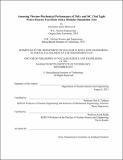Assessing thermo-mechanical performance of ThO₂ and SiC clad light water reactor fuel rods with a modular simulation tool
Author(s)
Mieloszyk, Alexander James
DownloadFull printable version (72.25Mb)
Other Contributors
Massachusetts Institute of Technology. Department of Nuclear Science and Engineering.
Advisor
Neil E. Todreas.
Terms of use
Metadata
Show full item recordAbstract
This work has focused on evaluating the thermo-mechanical performance of two innovative nuclear fuel designs: the ThO2-based resource-renewable boiling water reactor (RBWR) and silicon carbide (SiC) cladding in pressurized water reactors (PWRs). Since these designs employ non-traditional fuel rod materials and/or operating conditions, the fuel behavior and limits lie outside of current experience and must be appropriately assessed. The RedTail fuel performance code was developed to support early-stage innovative fuel designs using established models within a modular code structure. Additionally, the applied assumptions have been selected to allow for fast run times. This versatility and speed allow the RedTail fuel performance code to be applied towards broad scoping studies of new fuel rod concepts. With its use of (ThUPu)O2 and high cladding fluence, new physical models were applied to describe the ThO2-based RBWR fuel rods. The effects of lattice strain induced phonon scattering and semi-conductive electron transport on the thermal conductivity for this ternary fuel mixture were modeled. A new model has also been created to reconstruct the radial distribution of the fission rate in the fuel. Lastly, the effects of high fast neutron fluence on the accelerated oxidation and hydrogen pickup by Zircaloy-2 have been investigated and incorporated. In developing the ThO2-based RBWR concept, three designs have been proposed based on different goals and applied assumptions. With the exception of hydrogen uptake, none of the predicted parameters exceeded their limitations. However, the application of hydrogen-based cladding accident limits was found to be restricting. A sensitivity study revealed that in order to retain non-zero accident limits, an advanced cladding is required. Because of its lower corrosion rate and high strength in high temperature steam, composite ceramic SiC cladding has the potential to improve the response to severe accidents. Applicable SiC material properties have been investigated, and new swelling and thermal conductivity models have been applied to treat radiation damage effects. In addition, Weibull failure mechanics are applied to CVD SiC. The fuel performance of every SiC clad pin in a PWR core has been evaluated to find the core-wide leaker risk. To account for uncertainty in potential SiC cladding designs 24 separate cases were evaluated along with a comparison to ZIRLO®. The three-layer SiC architecture is found not to be a viable option due to large shutdown stresses. The two-layer design, however, shows much lower failure risk. This study indicates that significant opportunities exist to optimize core design to improve SiC cladding performance.
Description
Thesis: Ph. D., Massachusetts Institute of Technology, Department of Nuclear Science and Engineering, 2015. This electronic version was submitted by the student author. The certified thesis is available in the Institute Archives and Special Collections. "September 2015." Cataloged from student-submitted PDF version of thesis. Includes bibliographical references (pages 273-289).
Date issued
2015Department
Massachusetts Institute of Technology. Department of Nuclear Science and EngineeringPublisher
Massachusetts Institute of Technology
Keywords
Nuclear Science and Engineering.